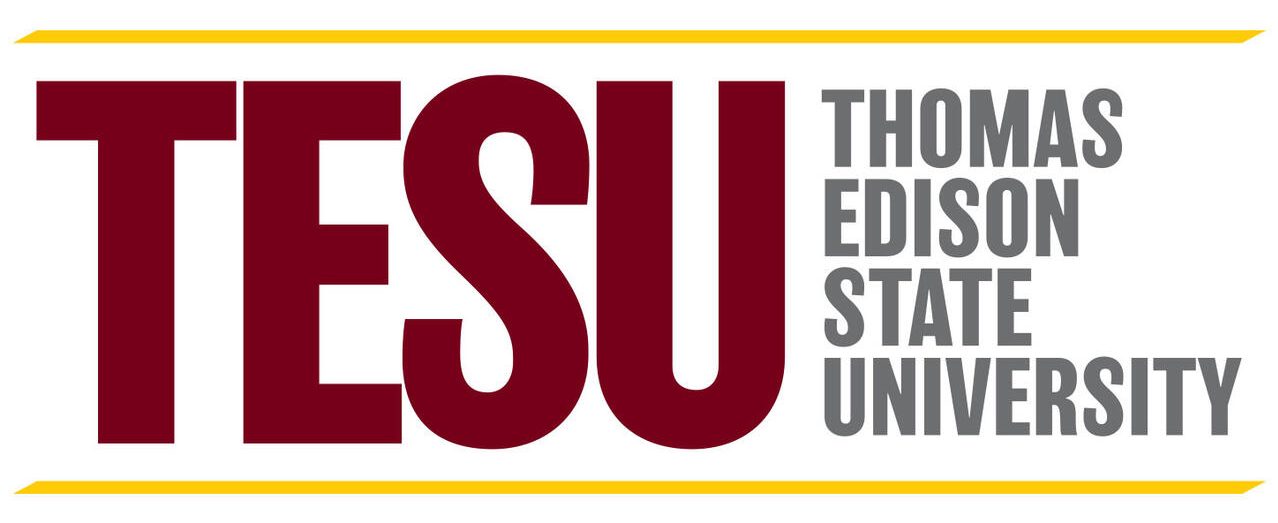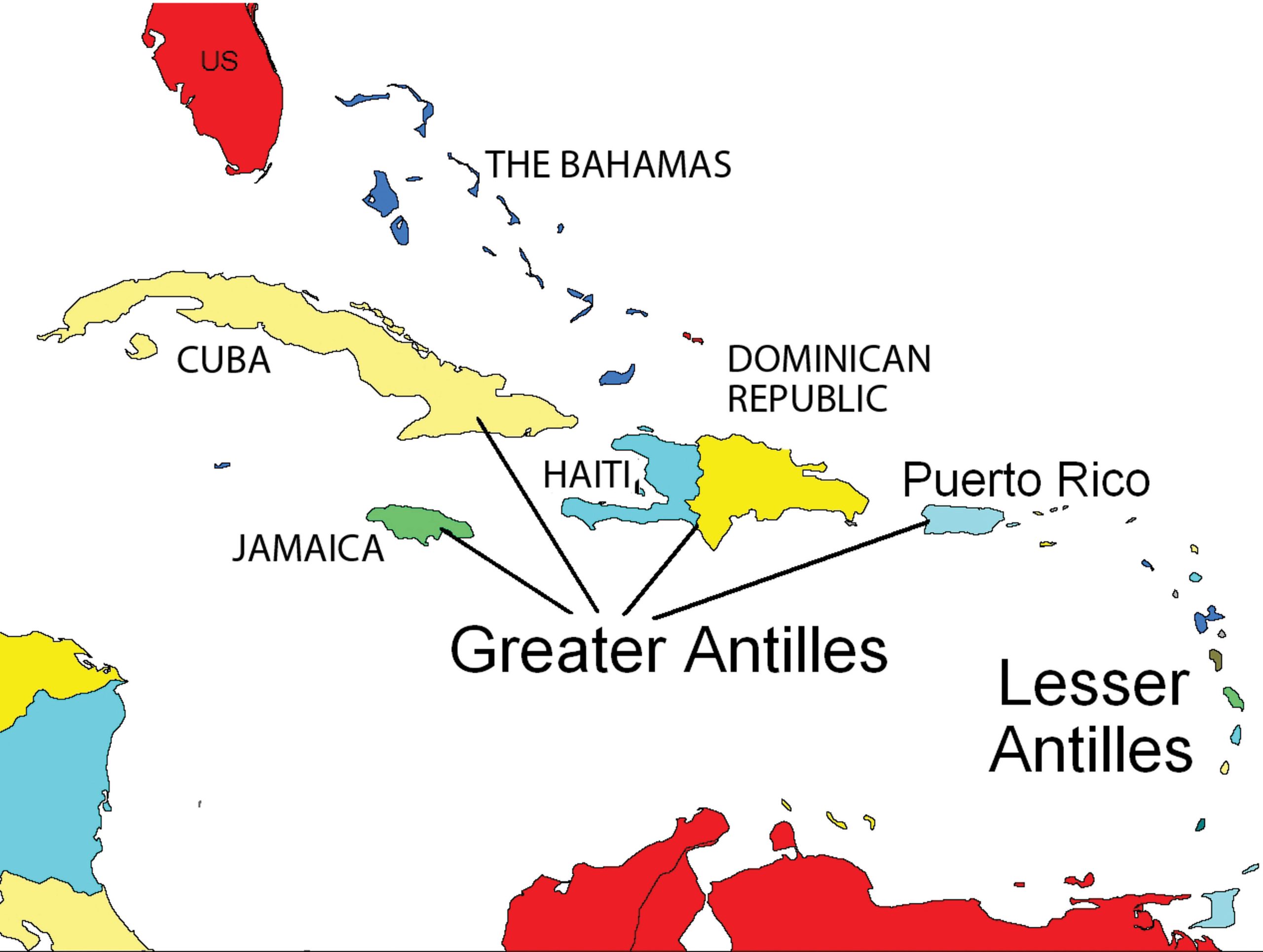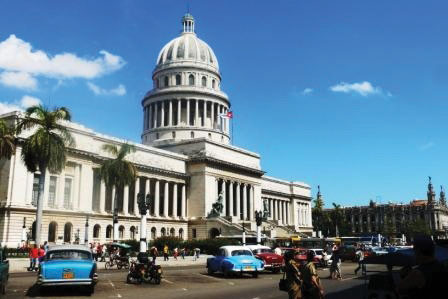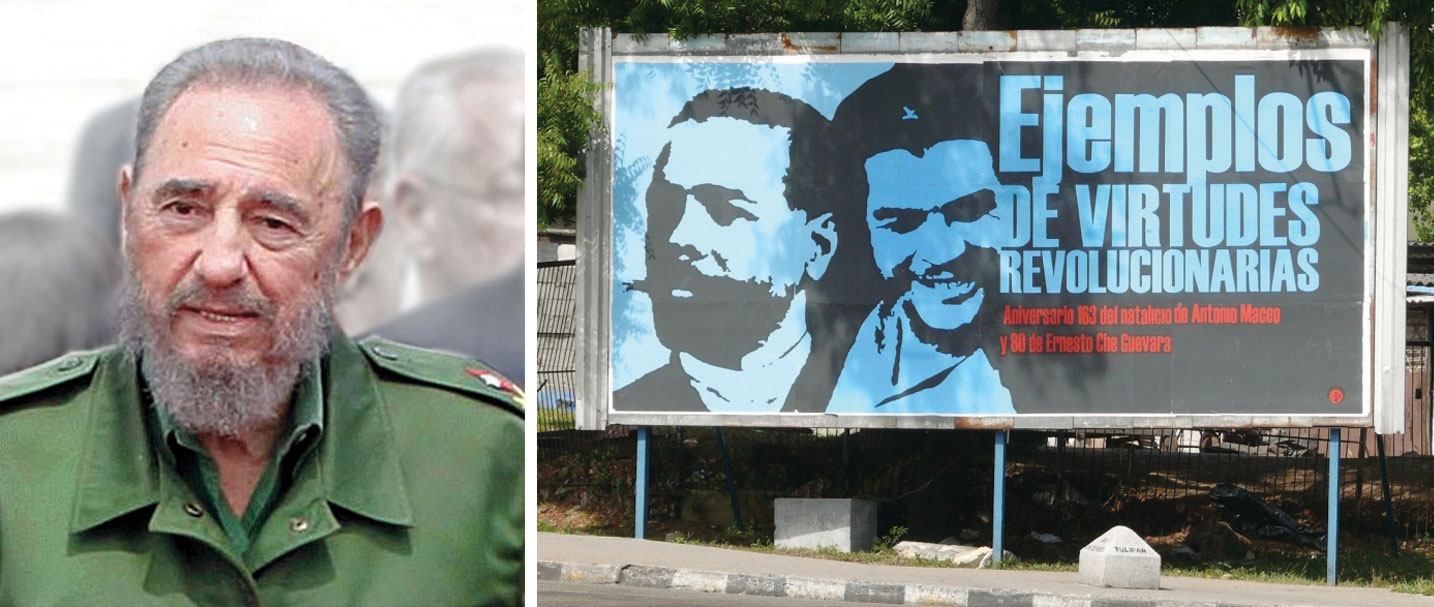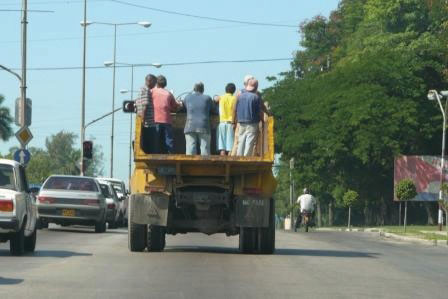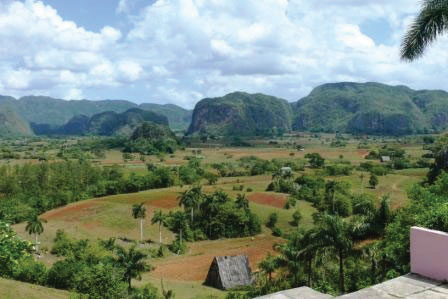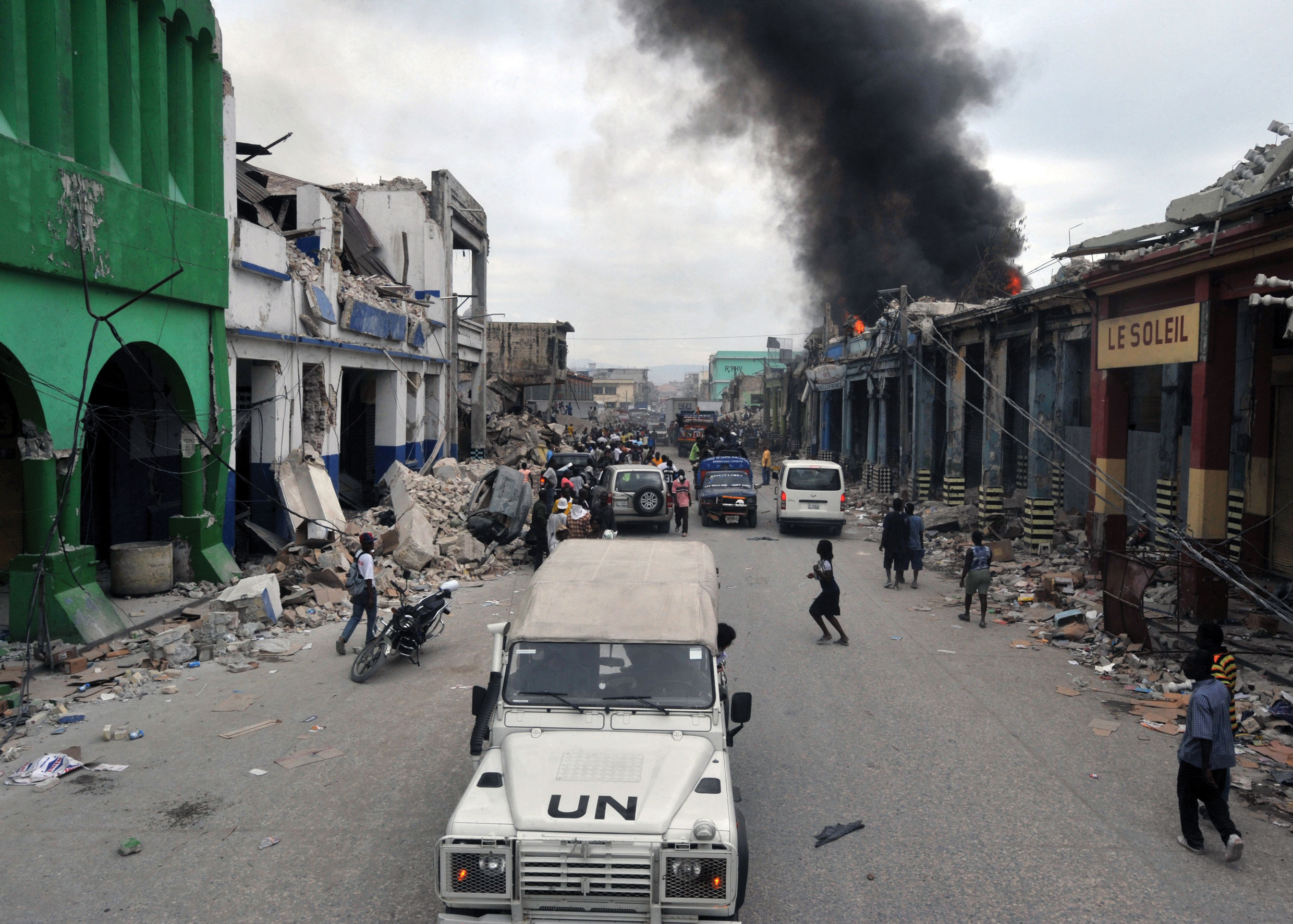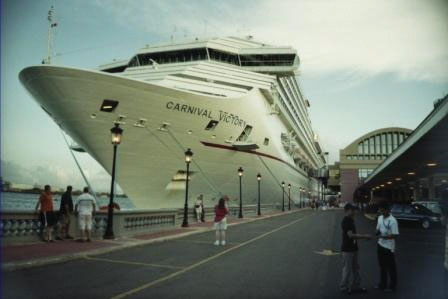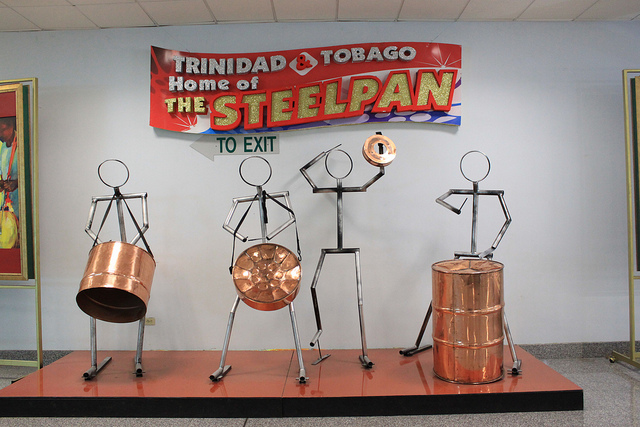Learning Objectives
- Describe how the physical environment has affected human activity in the region.
- Outline the various ways in which colonialism has impacted the islands.
- Explain why the United States has an economic embargo against the socialist country of Cuba.
- Explain how tourism has become the main means of economic development for most of the Caribbean.
- Identify the main music genres that have emerged from the Caribbean.
The regions of Middle America and South America, including the Caribbean, follow similar colonial patterns of invasion, dominance, and development by outside European powers. The Caribbean Basin is often divided into the Greater Antilles and the Lesser Antilles (the bigger islands and the smaller islands, respectively). The Greater Antilles includes the four large islands of Cuba, Jamaica, Hispaniola, and Puerto Rico. The Lesser Antilles are in the eastern and southern region. The Bahamas are technically in the Atlantic Ocean, not in the Caribbean Sea, but they are usually associated with the Caribbean region and are often affiliated with the Lesser Antilles. Middle America can be divided into two geographic areas according to occupational activities and colonial dynamics. The rimland includes the Caribbean islands and the Caribbean coastal areas of Central America. The mainland includes the interior of Mexico and Central America.
Many of the Caribbean islands experience the rain shadow effect. Jamaica has as much as a twenty-inch difference in rainfall between the north side and south side of the island because most of the rain falls on the north side, where the prevailing winds hit the island. The Blue Mountains in the eastern part of the island provide a rain shadow effect. Puerto Rico has a tropical rain forest on the northeastern part of the island, which receives a large amount of rainfall. The rain shadow effect creates semidesert conditions on the southwestern side of Puerto Rico because the southwestern side receives little rainfall. Low elevation islands such as the Bahamas do not receive as much rain because they are not high enough to affect the precipitation patterns of rain clouds.
European Colonialism in the Caribbean
The Spanish were not the only Europeans to take advantage of colonial expansion in the Caribbean: the English, French, Dutch, and other Europeans followed. Most of the European colonial countries were located on the west coast of Europe, which had a seafaring heritage. This included smaller countries such as Denmark, Sweden, and Belgium. The Caribbean Basin became an active region for European ships to enter and vie for possession of each island.
Many of the Caribbean islands changed hands several times before finally being secured as established colonies (see Table 5.1 “Historical Caribbean Colonizers”). The cultural traits of each of the European colonizers were injected into the fabric of the islands they colonized; thus, the languages, religions, and economic activities of the colonized islands reflected those of the European colonizers rather than those of the native people who had inhabited the islands originally. The four main colonial powers in the Caribbean were the Spanish, English, Dutch, and French. Other countries that held possession of various islands at different times were Portugal, Sweden, and Denmark. The United States became a colonial power when they gained Cuba and Puerto Rico as a result of the Spanish-American War. The US Virgin Islands were purchased from Denmark in 1918. Sweden controlled the island of St. Barthelemy from 1784 to 1878 before trading it back to the French, who had been the original colonizer. Portugal originally colonized Barbados before abandoning it to the British.
Table 5.1 Historical Caribbean Colonizers
| Colonizer | European colonies |
|---|---|
| Spain | Cuba, Dominican Republic, Puerto Rico |
| British | Bahamas, Jamaica, Cayman Islands, Turks and Caicos Islands, Antigua, Dominica, St. Lucia, St. Vincent, Grenada, Barbados, Virgin Islands, Trinidad and Tobago, Montserrat, Anguilla, St. Kitts and Nevis |
| Dutch | Curacao, Bonaire, Aruba, St. Eustatius, Saba and Sint Maarten (south half) |
| French | Haiti, Guadeloupe, Martinique, St. Martin (north half), St. Barthelemy |
| United States | Puerto Rico, Virgin Islands, Cuba |
Colonialism drastically altered the ethnic makeup of the Caribbean; Amerindians were virtually eliminated after the arrival of Africans, Europeans, and Asians. The current social hierarchy of the Caribbean can be illustrated by the pyramid-shaped graphic that was used to illustrate social hierarchy in Mexico (Figure 5.10 “Socioeconomic Classes in Mexico and Most of Latin America”). Those of European descent are at the top of the pyramid and control a higher percentage of the wealth and power even though they are a minority of the population. In the Caribbean, the middle class includes mulattos, or people with both African and European heritage, many of which include managers, businesspeople, and professionals. In some countries, such as Haiti, the minority mulatto segment of the population makes up the power base and holds political and economic advantage over the rest of the country while the working poor at the bottom of the pyramid make up most of the population. In the Caribbean, the lower economic class contains the highest percentage of people of African heritage.
Not only was colonialism the vehicle that brought many Africans to the Caribbean through the slave trade, but it brought many people from Asia to the Caribbean as well. Once slavery became illegal, the colonial powers brought indentured laborers to the Caribbean from their Asian colonies. Cuba was the destination for over one hundred thousand Chinese workers, so Havana can claim the first Chinatown in the Western Hemisphere. Laborers from the British colonies of India and other parts of South Asia arrived by ship in various British colonies in the Caribbean. At the present time, about 40 percent of the population of Trinidad can claim South Asian heritage and a large number follow the Hindu faith.
The Greater Antilles
Cuba: A Rimland Experience
The largest island in the Greater Antilles is Cuba, which was transformed by the power of colonialism, the transition to plantation agriculture, and a socialist revolution. The island country of Cuba is slightly larger than the US state of Kentucky, but it has more than eleven million people, while Kentucky has just over 4.2 million. The elongated island has the Sierra Maestra mountains on its eastern end, the Escambray Mountains in the center, and the Western Karst region in the west, near Viñales. Low hills and fertile valleys cover more than half the island. The pristine waters of the Caribbean that surround the island make for some of the most attractive tourism locations in the Caribbean region.
It has been estimated that as many as one hundred thousand Amerindians inhabited Cuba when Christopher Columbus first landed on the island in 1492. Except for brief control by the British, the island was a Spanish colony until 1898. Plantation agriculture was established, and slaves provided the labor. History indicates that more than eight hundred thousand African slaves were brought to Cuba between 1800 and 1870. Slave labor was in high demand on the extensive sugar plantations that dominated the island’s economy. The African influence can still be witnessed today in the main religion of the island, Santeria, which is an overlay of African-based spirits on top of Catholic saints. At the present time, an estimated 70 percent of Cubans practice some aspect of Santeria.
With the defeat of Spain in the Spanish-American War, the United States gained possession of the Spanish possessions of Cuba, Puerto Rico, Guam, the Philippines, and various other islands and thus became a colonial power. Cuba technically became independent in 1902 but remained under US influence for decades. Sugar plantations and the sugar industry came to be owned and operated by US interests, and wealthy Americans bought up large haciendas (large estates), farmland, and family estates, as well as industrial and business operations. Organized crime syndicates operated many of the nightclubs and casinos in Havana. As long as government leaders supported US interests, things went well with business as usual.
Figure 5.27 US “Colonial” Influence in Cuba
The old capitol building in Havana, a replica of the US Capitol, was built by the United States during their control of Cuba. The building is a tourist area and no longer used for the government. The old US cars in the photo were made before the Cuban Revolution (1958) but are still used and make up about half the motor vehicles in Havana.
Photo by R. Berglee – CC BY-NC-SA.
The Cuban Revolution
In January of 1934, with the encouragement of the US government, Fulgencio Batista led a coup that took control of the Cuban government. Fidel Castro, once a prisoner under Batista and having fled to Mexico in exile for a number of years, returned to Cuba to start a revolution. Joining him were his brother Raúl Castro and revolutionaries such as Che Guevara, an Argentinean doctor turned comrade-in-arms. Starting in the remote and rugged Sierra Maestras in the east, Castro rallied the support of the Cuban people. By the end of 1958, the Cuban Revolution brought down the US-backed Batista government. Castro gained power and had the support of most of the Cuban population.
Figure 5.28 Fidel Castro (left); Billboard in Havana Promoting the Virtues of Revolutionaries Antonio Maceo and Che Guevara (right)
Wikimedia Commons – CC BY 3.0; R. Berglee – CC BY-NC-SA.
Castro worked to recover Cuba for Cubans. The government cleared rampant gambling from the island, forcing organized crime operations to shut down or move back to the United States. Castro nationalized all foreign landholdings and the sugar plantations, as well as all the utilities, port facilities, and other industries. Foreign ownership of land and businesses in Cuba was forbidden. Large estates, once owned by rich US families, were taken over and recovered for Cuban purposes.
The US Embargo Era
Castro’s policy of seizing (nationalizing) businesses and property raised concerns in the United States. As a result, US president Dwight D. Eisenhower severed diplomatic relations with Cuba in 1960 and issued an executive order implementing a partial trade embargo to prohibit the importation of Cuban goods. Later presidents implemented a full-scale embargo, restricting travel and trade with Cuba. In March 1960, the Central Intelligence Agency trained Cuban exiles for an invasion of Cuba at the Bay of Pigs, on the south side of the island. This failed invasion attempt only resulted in consolidating the Cuban people’s support for Castro and his socialist government.
To deter any further US plans of invading or destabilizing Cuba, Castro sought economic and military assistance from the Soviet Union. Soviet premier Nikita Khrushchev agreed to secretly send missiles armed with nuclear weapons capable of hitting targets within the United States. In September 1962, US spy planes identified the missile sites. On October 22, 1962, President John F. Kennedy announced a naval blockade of the island and informed Khrushchev that any Soviet ship crossing the blockade would be sunk. At the last second, the two leaders resolved this dispute (called the Cuban Missile Crisis) before it erupted into a potential nuclear war. Khrushchev recalled the ships and agreed to dismantle the Cuban missile sites. In return, the United States agreed not to invade Cuba and to remove US missiles from sites in Turkey that were aimed at the Soviet Union.
The collapse of the Soviet Union in 1991 caused a downturn in Cuba’s economy. With the loss of Soviet aid, the 1990s were a harsh time for Cubans, a period of transition. Castro turned to tourism and foreign investment to shore up his failing economy. Tensions between the United States and Cuba did not improve. In 1996, the United States strengthened the trade embargo with the Helms-Burton Act. At the turn of the twenty-first century, Cuba emerged as the lone Communist state in the Americas. Castro was the longest-governing leader of any country in the world. He never kept his promises of holding free elections; instead, he cracked down on dissent and suppressed free speech. He turned over power to his brother Raúl in 2006.
A Post-Castro Cuba
With Fidel Castro no longer in power, Cuba’s future looks more positive but difficult. The island has natural resources, a great climate, and an excellent location but is also struggling economically. Cuba has a high literacy rate and has standardized health care, though medical supplies are often in short supply. The Cubans who live in dire poverty look to the future for relief. Personal freedoms have been marginal, and reforms are slowly taking place in the post-Fidel era. As the largest island in the Caribbean, Cuba has the potential to become an economic power for the region. There is vast US interest in regaining US dominance of the Cuban economy, and corporate colonialists would like to exploit Cuba’s economic potential. Keeping corporate colonialism out is what Fidel’s socialist experiment worked so hard to achieve, even at the expense of depriving the Cuban people of civil rights and economic reforms.
Cuba today is in transition from a socialist to a more capitalist economy and relies on outside sources for energy and food. In 2008, the average wage in Cuba was about twenty dollars per month. There was almost total employment, and everyone was on an equal footing in regard to free health care, education, and housing. At the same time, the underground informal economy was thriving and was pushing the formal economy to make changes. That same year, Raúl Castro declared that workers with different skills and occupations could earn wages at varying levels. Cubans are now allowed to have cell phones and computers, though Internet access has been restricted by the Cuban government. More goods and money are being brought in from Cuban family members who live in the United States. The US government grants general licenses to allow a number of categories of people to travel to Cuba. It is only a matter of time before full travel restrictions are lifted.
Cuba is counting on tourism for an added economic boost. With some of the finest beaches and the clearest waters in the Caribbean, Cuba is a magnet for tourists and water sports enthusiasts. Its countryside is full of wonders and scenic areas. The beautiful Viñales Valley in western Cuba has been listed as a UNESCO World Heritage Site for its outstanding karst landscape and traditional agriculture as well as for its architecture, crafts, and music. Karst topography is made up of soluble rock, such as limestone, which in the Viñales Valley results in unusual bread loaf–shaped hills that create a scenic landscape attractive for tourism. This region is also one of Cuba’s best tobacco-growing areas and has great potential for economic development. Cuba is gearing up for an increase in tourism when travel restrictions are lifted by the United States. There is already a focus on improving tourism services to people traveling there from China, Australia, Japan, and other countries. Millions more from the United States are expected to travel to Cuba once the travel restrictions are lifted. The Cuban economy is banking on tourism to forge a path to a more prosperous future.
The Commonwealth of Puerto Rico
Populated for centuries by Amerindian peoples, the island of Puerto Rico was claimed by the Spanish Crown in 1493, following Columbus’s second voyage to the Americas. In 1898, after four hundred years of colonial rule, during which the indigenous population was nearly exterminated and African slave labor was introduced, Puerto Rico was ceded to the United States as a result of the Spanish-American War. Puerto Ricans were granted US citizenship in 1917. Popularly elected governors have served since 1948. In 1952, a constitution was enacted providing for internal self-government. In elections held in 1967, 1993, and 1998, Puerto Rican voters chose to retain the commonwealth status, although they were almost evenly split between total independence and becoming a US state.
Puerto Rico is the smallest of the four islands of the Greater Antilles and is only slightly larger than the US state of Delaware. Puerto Rico’s population is about four million, similar to the population of Kentucky or Oregon. As US citizens, Puerto Ricans have no travel or employment restrictions anywhere in the United States, and about one million Puerto Ricans live in New York City alone. The commonwealth arrangement allows Puerto Ricans to be US citizens without paying federal income taxes, but they cannot vote in US presidential elections. The Puerto Rican Federal Relations Act governs the island and awards it considerable autonomy.
Figure 5.31 US Government Building in San Juan, Puerto Rico, with Both US and Puerto Rican Flags
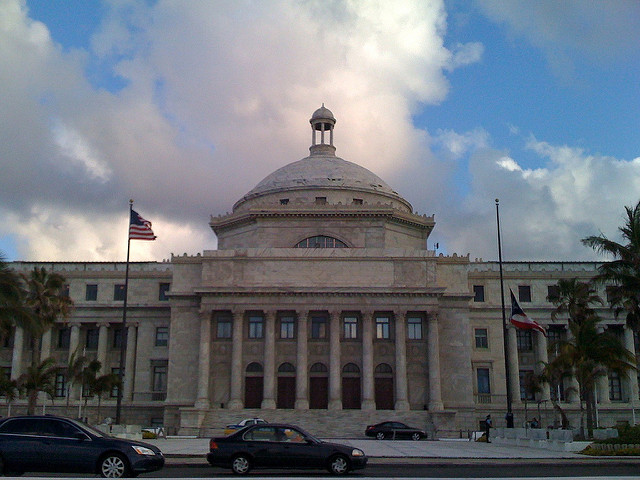
Rafael Torres – Puerto Rico Capitol Building – CC BY-NC-ND 2.0.
Puerto Rico has one of the most dynamic economies in the Caribbean Basin; still, about 60 percent of its population lives below the poverty line. A diverse industrial sector has far surpassed agriculture as the primary area of economic activity. Encouraged by duty-free access to the United States and by tax incentives, US firms have invested heavily in Puerto Rico since the 1950s, even though US minimum wage laws apply. Sugar production has lost out to dairy production and other livestock products as the main source of income in the agricultural sector. Tourism has traditionally been an important source of income, with estimated arrivals of more than five million tourists a year. San Juan is the number one port for cruise ships in the Caribbean outside Miami. The US government also subsidizes Puerto Rico’s economy with financial aid.
The future of Puerto Rico as a political unit remains unclear. Some in Puerto Rico want total independence, and others would like to become the fifty-first US state; the commonwealth status is a compromise. Puerto Rico is not an independent country as a result of colonialism. Many of the islands and colonies in the Caribbean Basin have experienced dynamics similar to Puerto Rico in that they are still under the political jurisdiction of a country that colonized it.
Hispaniola: The Dominican Republic and Haiti
Sharing the island of Hispaniola are the two countries of Haiti and the Dominican Republic. The island became a possession of Spain under European colonialism after it was visited by Columbus in 1492 and 1493. The Tiano-Arawak people were nonviolent and welcomed the Europeans, who in turn pressed them into servitude and slavery. French buccaneers settled on the western portion of Hispaniola and started growing tobacco and agricultural crops. France and Spain finally agreed to divide the island into two colonies: the western side would be French, and the eastern side would be Spanish.
The Dominican Republic holds the largest share of Hispaniola. A former Spanish colony, the Dominican Republic has weathered the storms of history to become a relatively stable democratic country. It is not, of course, without its problems. The Dominican Republic has long been viewed primarily as an exporter of sugar, coffee, and tobacco, but in recent years the service sector has overtaken agriculture as the economy’s largest employer. The mountainous interior and the coastal beaches are attractive to the tourism market, and tourism remains the main source of economic income. The economy is highly dependent on the United States, which is the destination for nearly 60 percent of its exports. Remittances from workers in the United States sent back to their families on the island contribute much to the economy. The country suffers from marked income inequality; the poorest half of the population receives less than one-fifth of the gross domestic product (GDP), while the richest 10 percent enjoys nearly 40 percent of GDP. High unemployment and underemployment remains an important long-term challenge. The Central American-Dominican Republic Free Trade Agreement (CAFTA-DR) came into play in March 2007, boosting investment and exports and reducing losses to the Asian garment industry. In addition, the global economic downturn has not helped the Dominican Republic.
Plantation agriculture thrived in Haiti during the colonial era, producing sugar, coffee, and other cash crops. The local labor pool was insufficient to expand plantation operations, so French colonists brought in thousands of African slaves to work the plantations, and people of African descent soon outnumbered Europeans. Haiti became one of the most profitable French colonies in the world with some of the highest sugar production of the time. A slave revolt that began in 1792 finally defeated the French forces, and Haiti became an independent country in 1804. It was the first country ever to be ruled by former slaves. However, the transition to a fully functional free state was difficult. Racked by corruption and political conflicts, few presidents in the first hundred years ever served a full term in office.
The United States occupied Haiti from 1915 to 1934 in an attempt to instill a US presence and bring some sense of stability. From 1957 to 1986, Dr. François “Papa Doc” Duvalier and then his son Jean-Claude “Baby Doc” Duvalier controlled the government. They created a private army and terrorist death squads known as Tonton Macoutes. Many Haitians fled to the United States or Canada, especially to French-speaking Quebec. After the Duvalier era, a Catholic priest by the name of Jean-Bertrand Aristide won the presidency through democratic elections only to be deposed of by a military coup a few years later. Haiti has had a difficult time finding political and economic stability.
Haiti is the poorest nation in the Western Hemisphere, and many Haitians live in dire poverty with few employment opportunities. An elite upper-class minority controls the bulk of the nation’s wealth. Many people in Haiti have sought comfort in Voodou (Vodoo), a religious practice steeped in African beliefs brought over with the slave trade. Often misunderstood by outsiders, Vodou’s its main objective is to bring good health and well-being.
Haiti’s January 12, 2010, earthquake was a major setback for such a poor country that was already in need of aid and support. The 7.0 magnitude earthquake, with many aftershocks, struck Haiti about fifteen miles from Port-Au-Prince, resulting in as many as two hundred thousand deaths. More than two million were immediately homeless, and about a million more were in need of aid. The lack of building standards in Haiti contributed to the collapse of structures and the devastation. Food and other aid were brought in by many international agencies and other countries to address the situation. Efforts continue to address the needs of the Haitian people to stabilize the situation and provide support and future opportunities.
Figure 5.32
UN peacekeeping troops patrol the streets of Port au Prince after Haiti’s 2010 earthquake.
Wikimedia Commons – CC BY 2.5.
Jamaica
The tropical island of Jamaica is physically smaller than the US state of Connecticut. In 2010, it had a population of about 2.8 million. Jamaica was settled by the Spanish early in the sixteenth century. The Taino Indians, who had inhabited Jamaica for centuries, were gradually eradicated and replaced by African slaves. When England seized the island from Spain in 1655, it established a plantation economy based on sugar, cocoa, and coffee. Two hundred years later (1834), the abolition of slavery freed a quarter million slaves, many of whom became small farmers. Jamaica gradually obtained independence from Britain, with full independence achieved in 1962. Sugar, cocoa, and coffee production continue on the island, of which more than half is mountainous. The Blue Mountains of eastern Jamaica are known for their Blue Mountain coffee production.
Deteriorating economic conditions during the 1970s led to recurrent violence as rival gangs affiliated with the major political parties evolved into powerful organized crime networks involved in international drug smuggling and money laundering. Violent crime, drug trafficking, and poverty pose significant challenges to the country. Nonetheless, many rural and resort compounds remain relatively safe and contribute substantially to the tourism sector. The beautiful beaches and lush interior make for an attractive destination for cruise ships and other tourists.
Tourism and Economic Activity in the Rimland
The physical geography of the Caribbean region makes it a prime location for tourism. Its beautiful coastal waters and warm tropical climate draw in tourists from all over North America and the world. Tourism is the number one means of economic income for many places in the Caribbean Basin, and the tourist industry has experienced enormous growth in the last few decades. Tourism is a major component of efforts by leaders of the islands of the Lesser Antilles to achieve economic development for their people. In the last decade, there has been strong growth in the number of cruise ships operating in the Caribbean. Cruise ships from the southern coasts of the United States ply their trade around the islands and coastal regions. San Juan receives the largest number of cruise ship travelers, but other areas well known to tourists include the Bahamas, St. Martin, and the Virgin Islands. Even the poorest country in the Caribbean, Haiti, has tried to attract cruise ships to its ports. The western Caribbean itinerary includes the Cayman Islands, Jamaica, and Mexico or Central American ports. The main restriction on cruise ship travel is the hurricane season, from June to November.
One might reasonably think that the economic benefits of tourism would be entirely positive. However, this is not necessarily the case. Even though tourism has become a vital economic component of the Caribbean Basin, in the long term, tourism creates many problems. Large cruise ships and pleasure crafts can overtax the environment; there have been occasions where there were actually more tourists than citizens on an island. An increase in tourist activity brings with it an increase in environmental pollution.
Most people in the Caribbean Basin live below the poverty line, and the investment in tourism infrastructure, such as exclusive hotels and five-star resorts, takes away resources that could be allocated to schools, roads, medical clinics, and housing. However, without the income from tourism, there would be no money for infrastructure. Tourism attracts people who can afford to travel. Most of the jobs in the hotels, ports, and restaurants where wealthy tourists visit employ people from poorer communities at low wages. The disparity between the rich tourist and the poor worker creates strong centrifugal cultural dynamics. The gap between the level of affluence and the level of poverty is wide in the Caribbean. In the model of how countries gain wealth, tourism is a mixed-profit situation. Local businesses in the Caribbean do gain income from tourists who spend their money there; however, the big money is in the cruise ship lines and the resort hotels, which are mainly owned by international corporations or the local wealthy elite.
There is little activity in the Caribbean Basin in the manufacturing sector. Although US firms have invested in Puerto Rico and the Dominican Republic has experienced growth in light industries and information technologies, the remaining islands have had little industrial growth. Unless an island state has natural resources such as oil or minerals, as is the case with Trinidad and Tobago, there are few opportunities other than tourism to bolster the economy.
Agricultural products have been traditionally a large part of the economic activity of the islands of the Lesser Antilles. Grenada, for example, is known for its nutmeg and other spices. Bananas, sugar, and other fruit and food crops have also been export products. The problem has been that the profit margins on the products are low and prices are subject to international markets, which fluctuate widely. With an increasing population and few opportunities or advantages, countries such as Haiti suffer from poverty and unemployment. Being an island, there are few methods of expanding the economy. People often try to migrate to another county in search of employment and a more hopeful future.
Offshore Banking
Other methods of gaining wealth in the Caribbean include offshore banking and financial services. Various islands have established themselves as banking centers where one can set up financial accounts that are outside the jurisdiction of other countries. These offshore accounts provide tax havens for individuals or corporations that wish to evade taxes in their home countries. Many of these island banking centers do not share account information with tax agencies or government offices of other countries. Places such as the Cayman Islands have a worldwide reputation for professional financial services for offshore banking. As a result, the people of the Cayman Islands have a high standard of living with much national wealth. The Bahamas and the Turks and Caicos have also established offshore financial centers, and other Caribbean Islands are working to increase their visibility with similar services. All are hoping to gain income from this low-impact and high-income enterprise. The United States and other countries have made attempts to pressure these islands to share the financial account information of people evading taxes. If successful, there may be less of an incentive for individuals and businesses to use offshore accounts to shelter income from taxes or for those involved in illegal money-laundering schemes to hide money in the Caribbean.
The wide level of diversity in the Caribbean has not made it easy for outside entities to provide support and assistance for common economic goals. The Caribbean Community (CARICOM) is an organization with fifteen Caribbean members established to promote economic integration and cooperation in the region. It hopes to coordinate foreign policy for the region and ensure that the benefits of integration are equitably shared. CARICOM is an attempt to compete with other trade organizations such as the North American Free Trade Agreement (NAFTA) and CAFTA-DR.
Caribbean Music
The Caribbean culture includes many varieties of music that have developed on several islands. The region is a breeding ground for innovative music and rhythms that emulate the cultural traditions and attitudes of the people. Every island has its own traditional festivals that include parades, music, and dance. The music scene reveals the uniqueness of the Caribbean. Listening to the myriad of sounds generated from the different islands opens a window to the assortment of cultural backgrounds found in the Caribbean.
The Caribbean is full of local musical variations, and many types of music are found only on a single island or two. For example, the Dominican Republic has meringue music, Dominica has bouyon, and Haiti has its festive rara music.
The Cuban influence on music is vividly evident in the spicy salsa tunes that have emanated from the Caribbean over the years. African and Spanish cultural influences have helped shape the salsa music that has evolved from Cuba and neighboring islands of Puerto Rico and the Greater Antilles. With a strong percussion component, snappy brass additions, and rhythmic guitar sections, salsa has become popular throughout many parts of Latin America. Other genres of music coming out of Cuba include rumba, habanera, son, and timba, to name a few.
Calypso music comes from a mix of African influences on the island of Trinidad. Calypso began taking shape at the beginning of the twentieth century and gained popularity through Carnival and other Caribbean festivals. It has evolved to incorporate the steel pan and other musical instruments. A commercial version of calypso became popular with Harry Belafonte’s version of the Jamaican folk tune of “Day-O,” known as the “Banana Boat Song”; however, Belafonte’s 1956 album Calypso had more of a Jamaican mento musical style and he was not from Trinidad. Mento is a more folksy rural style of acoustical music that influenced other forms of music such as reggae in Jamaica.
The pan (steel pan) is the national instrument of Trinidad and Tobago, where it was created. The pan was originally made from fifty-five-gallon oil drums. The bottom is cut off at various levels to provide different sounds. The top is then shaped into a chromatically pitched percussion instrument. It is struck with a pair of straight sticks. An entire family of pans has been developed and can be assembled into a steel pan orchestra. The instrument has become popular outside the Caribbean as well.
Reggae music started coming out of Jamaica in the 1960s with the music of such artists as Bob Marley and the Wailers, which featured Peter Tosh and Bunny Wailer. The rhythmic style with offbeat accents evolved from earlier genres to become a standard of Jamaican music. Musicians from the Beatles to Eric Clapton have used reggae rhythms. Outside Jamaica, reggae has hit the charts thanks to groups such as UB40. Reggae music has often been associated with the Rastafarian movement or Rasta, which is based on a religious ideology including the beliefs that former Ethiopian emperor Haile Selassie was God incarnate and the biblical Zion was in Africa.
Key Takeaways
- Colonialism created a high level of ethnic, linguistic, and economic diversity in the Caribbean. The main shifts were the demise of indigenous groups and the introduction of African slaves. The African influence can be witnessed in the religions of Santeria in Cuba, Vodoo (Voodou) in Haiti, and Rasta in Jamaica.
- The Caribbean Basin faces many challenges, including natural elements such as hurricanes, earthquakes, and volcanic activity. Economic conditions are often hampered by environmental degradation, corruption, organized crime, or the lack of employment opportunities.
- The Cuban Revolution led by Fidel Castro created a socialist state that nationalized foreign-owned assets and brought about a trade embargo by the United States. Cuba lost its aid from the Soviet Union after the USSR’s collapse in 1991 and has been increasing its focus on tourism and capitalistic reforms.
- Tourism can bring added economic income for an island country, but it also shifts to the service sector resources that are needed for infrastructure and services. A high percentage of tourism income goes to external corporations.
- The diversity of the Caribbean is evident in the wide range of musical types generated from the islands. Individual islands are known for certain types of music; salsa, reggae, and calypso are examples.
Discussion and Study Questions
- Which islands make up the Greater Antilles? Where are the Lesser Antilles?
- Which European countries were the main colonizers of the Caribbean?
- How is Cuba a good example of a rimland country?
- Why does the United States still have an economic embargo against Cuba?
- How is the political system in Cuba different from that of the United States?
- Why is Puerto Rico a commonwealth of the United States?
- How is Haiti different from its neighbor, the Dominican Republic?
- What are the positive and negative perspectives on the Caribbean tourism industry?
- Besides tourism, what other methods do people in the Caribbean islands use to generate wealth?
- How do differences in musical styles tell a story of Caribbean culture?
Geography Exercise
Identify the following key places on a map:
- The Bahamas
- Blue Mountains
- Greater Antilles
- Lesser Antilles
- Sierra Maestra
- Viñales Valley
